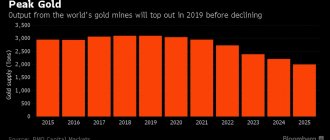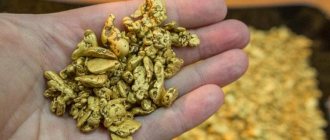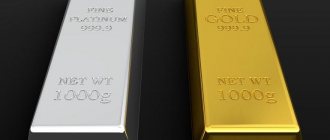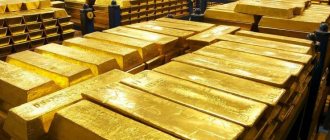Gold of the Russian Empire under Tsar Nicholas II
Let me start with the fact that before the start of the First World War, the Russian Empire, through the efforts of Tsar Nicholas II, had the world's largest gold reserves. It was 1311 tons. In modern terms, this is approximately 150 billion US dollars.
SEE ALSO: THE WEST SUSPECTED THAT RUSSIA IS PREPARING A GOLD TRAP FOR THE USA
Subsequently, this reserve was significantly reduced. The World War and the October Revolution made adjustments. A certain amount of gold reserves went to pay for weapons and other assistance to the Entente countries in 1914-1917.
As a result, the gold reserves by the October Revolution of 1917 amounted to 1,100 tons.
After this, Russian gold partially fell into the hands of the White Czechs and White Guard generals, and was exported abroad. Including to Japan, Czech Republic, France, Great Britain. Where it is still located.
The Bolsheviks also had a hand in reducing the supply. For example, in the 1920s they spent more than 200 tons just buying steam locomotives from Europe. And part of the gold was paid to the Baltic countries. For example, Estonia received over 11 tons of gold under the Tartu Peace Treaty.
As a result, in 1923 the USSR's gold reserves were only 400 tons.
Gold and foreign exchange reserves of the country in 1991: Notes from Yu.V. Poletaeva, V.V. Gerashchenko and A.P.Nosko
Document 1. Note from the Deputy Chairman of the Board of Vnesheconombank of the USSR Yu.V. Poletaev.
“The state of settlements of the USSR in freely convertible currency for 9 months of 1991 was as follows. The receipt of freely convertible currency from current exports amounted to 26.3 billion US dollars. Of these, 15.9 billion US dollars went to the centralized fund for repaying external debt and paying for central imports, and 10.4 billion US dollars went to the foreign exchange funds of exporters. At the same time, payments from centralized foreign exchange funds amounted to US$26 billion. At the same time, the situation is further complicated by the outflow of deposits and short-term financial loans, which since the beginning of the year amounted to a net basis of 4.1 billion US dollars.
Thus, the lack of export earnings to make payments on centralized funds amounted to 10.6 billion US dollars. In this regard, based on the decisions taken by the country’s leadership during the year, this deficiency was covered by conducting swap operations with gold (i.e., loans secured by gold) and its sale - 3.4 billion US dollars, attracting new financial loans - 1.7 billion US dollars and the use of funds from foreign exchange funds of enterprises, organizations, republics and local authorities from the accounts of Vnesheconombank of the USSR - 5.5 billion US dollars.
Due to the extreme aggravation of the payment situation, the country repeatedly found itself on the verge of insolvency during the year due to a lack of liquid resources in freely convertible currency, which was repeatedly reported to the country's leadership.
And at the end of October 1991, liquid foreign exchange resources were completely exhausted, and therefore Vnesheconombank of the USSR was forced to suspend all payments abroad, with the exception of payments to service external debt, which was reported to the Committee for the Operational Management of the National Economy of the USSR.
The shortfall in receipts from current exports for payments abroad only for obligations existing on December 1, 1991 (even without taking into account the minimum requirement for freely convertible currency to pay for imports, including transportation) could amount to more than $3.5 billion, including in November — 1.3 billion US dollars. By the end of the second ten days of November, liquid foreign exchange resources are expected to be insufficient even to fulfill the unconditional obligations of the state, and the country may be declared insolvent.”
(This note was published in the book of memoirs of E.T. Gaidar. The note is quoted from the publication: E.T. Gaidar. Works in 2 volumes. Vol. 1. Days of defeats and victories. M., 1997. - P. 310 -311).
Document 2. Note from the Chairman of the Board of the State Bank of the USSR V.V. Gerashchenko
To the President of the USSR Comrade Gorbachev M.S.
November 15, 1991 No. 10205/290
In accordance with historical tradition and international practice, the State Bank of the USSR, as a single emission center of the country, has on its balance sheet gold in the amount of 374.6 tons. By its purpose, this monetary reserve serves as a guarantee of cash in circulation and a guarantee that the central bank will fulfill its international obligations.
Beginning in 1922, bank notes were issued for circulation against the security of a set amount of gold purchased by the State Bank. By mid-1937, the monetary reserve of gold on the balance sheet of the State Bank of the USSR amounted to 374.6 tons. After 1937, its replenishment in order to provide gold for banknotes issued was stopped, and the cash reserve of gold was transferred to the storage of the People's Commissariat of Finance of the USSR. The transfer of 374.6 tons of gold to Gokhran was formalized with appropriate receipts.
Official gold reserves were replenished through new mining and were used in some years to sell the metal on the foreign market. However, the monetary reserve of the State Bank of the USSR, reflected on its balance sheet, remained unchanged for more than 50 years. At the same time, data on the size of gold reserves has been closed since the 30s.
In connection with the publication of the balance sheet of the State Bank of the USSR in June 1991, the size of the monetary gold reserve was announced, which caused a positive reaction in international financial circles.
In October of this year. It was stated that the country's official gold reserves amount to only about 240 tons. The announced level of official gold reserves, which is one of the most important indicators of a country's creditworthiness according to experts, does not correspond to the status of a great power and a leading gold-mining country. Reports about the size of the USSR's gold reserves caused bewilderment among specialists in the gold market, who previously estimated them at 1000-3000 tons. It should be noted that the announced size of our gold reserves is 10 times less than the monetary reserves of France and Switzerland, 5 times less than the Netherlands, and 4 times - Belgium, etc. In terms of gold reserves, we are also inferior to developing countries such as China, India, Venezuela, and Lebanon.
Considering the declared size of the country's gold reserves, it is obvious that part of the gold on the balance sheet of the State Bank of the USSR was spent without its consent by the previous government.
In connection with the above, the State Bank of the USSR considers it necessary to take the following measures:
- \
- Restore the gold reserves of the State Bank of the USSR in the amount of 374.6 tons by transferring to its balance sheet unfinished collateral transactions with gold of the “swap” type, carried out by Vnesheconombank of the USSR at the expense of state gold reserves. Ensure the repurchase of gold for these operations through foreign loans received by the State Bank of the USSR and Vnesheconombank of the USSR.
- Introduce to the State Council a proposal to preserve on the balance sheet of the State Bank of the USSR (and subsequently on the balance sheet of its legal successor) the historically established monetary reserve of gold as an indivisible centralized gold reserve of the states included in the economic community.
- Considering that, with rare exceptions, gold reserves and currency values that serve as security for cash in circulation and the country’s international obligations are stored in special vaults of central banks, ensure the transfer of physical metal for storage to the State Bank of the USSR. To entrust the State Bank of the USSR, and subsequently its successor, to manage, in full accordance with international practice, the centralized gold fund of the states forming the economic community, with the aim of strengthening the ruble as a collective currency and ensuring the external obligations of the community.
\
Please consider V.V.
Gerashchenko Note from V.V. Gerashchenko in pdf format
Document 3. Note from the Deputy Chairman of the Board of Vnesheconombank of the USSR A.P. Nosko dated November 26, 1991.
Operations Committee
people's management
economy of the USSR
In connection with the instructions of the Committee for Operational Management of the National Economy of the USSR dated November 6, PK-2573 Vnesheconombank of the USSR reports.
As has already been reported to the Inter-Republican Economic Committee, liquid foreign exchange resources have been completely exhausted and current foreign exchange earnings from exports do not cover the obligations to repay the country’s external debt.
Taking into account the above, Vnesheconombank of the USSR will be able to pay the overdue debt, England, only if a real source is allocated in freely convertible currency.
A.P.Nosko
Note by A.P. Nosko in pdf format
Gold of the USSR under Stalin, Brezhnev and Gorbachev
After Stalin came to power, the situation began to change. Despite the huge purchases of industrial equipment abroad and the construction of thousands of factories, the USSR's gold reserves were rapidly replenished.
In 1941, it reached an all-time high. Stalin increased the gold reserves to 2800 tons.
SEE ALSO: THE MEDIA BELIEVES THAT RUSSIA’S “GOLDEN” PLAN WAS SMARTER THAN EXPECTED
True, the Second World War adjusted this value. But even after the war, gold continued to be mined and purchased. As a result, in 1953, the USSR's gold reserves almost reached the pre-war level and amounted to 2.5 thousand tons of the precious metal.
Later, after Stalin, the gold reserves were used by the leaders of the Soviet Union to “patch holes” in the budget. The minimum value of gold reserves after the Second World War was reached during the time of Brezhnev. In 1978, the USSR had only 498 tons of gold, and in 1982 - 438 tons.
Despite my dislike for Gorbachev, I want to state that the gold reserves of the USSR gradually grew during his reign. But in 1991 there was a collapse. There are only 290 tons of gold left in the country. This is a historical minimum under the Soviet Union after the Second World War.
USSR gold reserves
How did the Soviet government accumulate such impressive sums: 2,400 tons of gold and 11 billion US dollars? The influx of funds into the USSR treasury was impressive. All party members, who numbered about 20 million in 1985, paid regular dues. Part of the money went to the maintenance of the state apparatus, part was sent to the “storage”. In addition, the CPSU made money from the sale of communist literature.
Money for the reserve also came from the Soviet peace fund, which was formed from voluntary donations. We should not forget that in the USSR churches and temples paid taxes. Numerous streams of money turned the treasury into a huge storehouse. For reliability, funds were exchanged for gold bars on the foreign market.
Lend-Lease gold
Wallace's book is pure populism. The ruling circles of the United States knew very well the price of Soviet gold and the fact that it was obtained through the extreme hard labor of prisoners and civilian citizens of the USSR. It was the gold of the hated communist totalitarian country - the USSR, which was a temporary ally during the Second World War. Despite all the hatred for the communist system, American business could not refuse fantastic profits. There was a lot, a lot of gold, and the Americans could not let this golden “pie” pass them by. Stalin used gold to “buy” American loyalty to the USSR, and also took the USSR away from attack in a possible Third World War. It is known that the US atomic bomb, according to President Truman, was created “against these Russian guys,” and not against Japan. Our allies were conducting secret negotiations with the Nazi elite, the plans “Unthinkable”, “Dropshot” and others were already on the tables of American headquarters, the only thing missing was nuclear bombs, but it was only a matter of time. But the USSR paid and paid in gold. America loved it like a cobra enchanted by the music of the magic flute. Meanwhile, Stalin was tearing up the people and engineering minds by creating the atomic bomb and more. And when the USSR tested its nuclear weapons in 1949, it stopped Lend-Lease payments.
The Americans came to their senses, but it was too late. Stalin strategically outmaneuvered his allies at the start of the Cold War. In those historical realities of constant time pressure and external pressure, Stalin’s Gulag and Dalstroy had no alternative. Many historians agree with this, sad as it may be to admit. Varlam Shalamov and Oleg Volkov told us about the terrible pages of the Gulag. Alexander Solzhenitsyn called Kolyma a pole of cold and cruelty. His talented pen spoke about thousands of crippled lives. These sacrifices were not in vain - their memory is eternal. But there were thousands and thousands of ordinary residents and volunteers who, after a hard day of work, went to a mine, a mine, and went to extract gold, which the Motherland desperately needed. This was the case in all gold-bearing regions of the USSR during the harsh war years. Pavel Yakovlevich Yaroshchik recalled: “They talked about Indigirka in the Susumansky district of the Magadan region with horror. Even the cars don't work there, they stall. But when they started looking for volunteers, I was the first to agree. I was a young guy, there was a war going on, and I believed that I should be there. “The machines may stall,” I thought, “but someone has to mine the gold, so why not me?” [6; With. 107]. They went to the face, to the mine and to the mines because they knew that nature gave them only a hundred days (K.V.: that’s how long the mining season lasted in the north-east of the country). In fact, this mass heroism of the Soviet people at the front and in the rear became the main source of Victory in the Great Patriotic War.
Afterword
“Gold is a metal that is dug out of the ground when a crisis comes, and buried back when the crisis passes.” A joke by financier W. Buffett
INFORMATION SOURCES:
Zelyak V.G. Gold for Victory: Dalstroy’s mining industry during the war years // Russia and the Asia-Pacific region. – 2010. – No. 2. – P.55–63.
Rudakov V.V., Smirnov A.P. Gold of Russia. – M.: Krugozor Nauka, 2006. – 710 p.
Zelyak V.G. Five metals of Dalstroy. – Magadan: 2004. – 283 p.
Shirokov A.I. State policy in the northeast of Russia in 1920–1950. Experience and history lessons. Tomsk: Publishing house. Tomsk University, 2009. – 450 p.
Sapogovskaya L.V. History of gold mining in the USSR // Sat. Economic history, 2003. ROSSPEN, 2004. – 597 p.
Devil's Yu. Golden Indigirka. // Polar Star. – 1969. – No. 6. – P.94–111.
Shevyakov D.K. My running is not a run, but an escape. – Magadan, 2000. – 40 p.
Mezentsova I.V. “Baleizoloto” during the Great Patriotic War // Scientific Bulletin of the Baikal State University. – 2004. – No. 3. – P.62–70.
Kavchik B.K. Non-industrial gold mining in the USSR under Stalin. Internet: “Gold Mining” (accessed October 18, 24, 30, 2017)
Yarullina A.Z. Gold mining in the southeastern regions of Bashkortostan during the war. Ufa: RAS, 2005. 189 pp./ Internet: urgaza. ru. (accessed October 24, 2021)
Zubrilov L.E. Dementyev I.V. The contribution of the mining Urals to the Victory. – Ekaterinburg: 1995. – 160 p.
Desyatkin T.G. Gold, diamonds and my life. – M.: Yana, 1988. – 222 p.
Conquest R. Harvest of Sorrow // Neva. – 1990. – No. 8. 125–146 p.
Katasonov V.Yu. The mystery of the gold reserve / Internet: Historian. Magazine about the current past (date of access: November 18, 23, 2017)
Sirotkin V.A. Foreign gold of Russia. – M.: Olmapress, 2000. – 463 p.
Key words: gold, war, heroism, Dalstroy, Glavzoloto, Kolyma, I. Stalin
Gold mining
Before the First World War, 60.8 tons of gold were mined in Russia in 1913. At that time the industry was in the hands of foreigners. However, wars and revolutions destroyed the gold mining industry. During the NEP, gold mining began to revive. In 1927, only 20 tons of gold were mined.
Despite the collapse of the NEP, Stalin in 1927 allowed private miners to continue their business, understanding their merits and importance for the gold mining industry (it is believed that he paid attention to the experience of the gold rush in the United States, where it was private initiative that drove the processes).
At the beginning of 1928, the Kolyma gold rush broke out. In the spring of 1928, F. R. Polikarpov ceded his rights to the Bezymyanny spring deposit to the state joint-stock company Soyuzzoloto. After the hype of private mining, the stage of state development of Kolyma riches began.
Alexander Pavlovich Serebrovsky traveled to the USA twice and adopted the experience of American gold miners. He studied technology and equipment and recruited American engineers to work in the Soviet Union.
In 1932, in addition to civilian gold mining, which was under the jurisdiction of the People's Commissariat of Heavy Industry, Dalstroi began mining the precious metal - Kolyma prisoners - almost free labor.
The amount of gold mined in the Soviet Union increased every year. In the second half of the 1930s, the USSR ranked second in gold mining, ahead of the USA and Canada. The Soviet Union was second only to South Africa.
Between 1932 and 1941 Dalstroy produced about 400 tons of gold. “Civilian” gold mining for the period 1927-1935 brought 300 tons.










